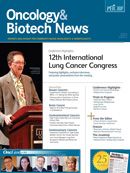Publication
Article
Oncology & Biotech News
Novel Drugs and Combinations Promise to Improve Outcomes for Patients With Myeloma
Author(s):
Current treatments revolutionized multiple myeloma but combinations and novel approaches in development promise to make even greater strides in treating this disease.

Kenneth C. Anderson, MD
Treatment of multiple myeloma has been revolutionized by therapies such as the thalidomide analog lenalidomide and the proteasome inhibitor bortezomib, as well as by giving these drugs in various combinations. Newer approaches with other novel agents in development promise to make even greater strides in treating this disease, according to Kenneth C. Anderson, MD, Kraft Family professor of Medicine at Harvard Medical School and director of the Jerome Lipper Multiple Myeloma Center and Lebow Institute for Myeloma Therapeutics, and vice chair of the Joint Program in Transfusion Medicine at Dana-Farber Cancer Institute in Boston, Massachusetts.
“Combination novel therapy represents a new treatment paradigm in multiple myeloma, targeting the tumor cell in the microenvironment, which has markedly improved response, complete remission, event-free survival, and overall survival [OS],” Anderson told attendees at the NCCN 6th Annual Congress: Hematologic Malignancies.
Currently approved agents for relapsed multiple myeloma include bortezomib, lenalidomide/dexamethasone, and bortezomib/pegylated doxorubicin. In patients refractory to bortezomib and/or lenalidomide, it is possible to reuse those agents in combinations and get good response. In one study of relapsed patients, the combination of lenalidomide, bortezomib, and dexamethasone achieved a 58% response rate, he said. Trials of this combination as initial therapy achieve a 100% response rate, he added.
“Patients with bortezomib- and lenalidomide-refractory myeloma should be treated with protocol therapies in clinical trials that include novel agents alone and in combination,” said Anderson.
“Over the past few years, we have learned how to give bortezomib, and this has transformed the field,” he continued. Bortezomib given twice a week (the original schedule) was associated with unacceptable peripheral neuropathy. Giving this drug weekly for 4 weeks out of 5 reduced the incidence of neuropathy by 50%, and that of grades 3 and 4 neuropathy to 2% to 3%. Subsequently, other investigators showed that subcutaneous delivery of bortezomib for relapsed myeloma was superior to intravenous delivery, reducing the overall incidence of neuropathy and grades 3 and 4 neuropathy to single digits, Anderson said.
Research is ongoing using genomic and proteomic studies to identify novel therapeutic targets and combination therapies. A pivotal phase III trial for FDA approval of elotuzumab is under way comparing lenalidomide, dexamethasone, and elotuzumab versus lenalidomide/dexamethasone alone in relapsed multiple myeloma. Carfilzomib (a next-generation proteasome inhibitor) is also being studied in a phase III trial for drug approval comparing carfilzomib, lenalidomide, and dexamethasone versus lenalidomide/ dexamethasone. In one study, the combination of carfilzomib, lenalidomide, and dexamethasone (CRd) achieved an overall response rate of 78% (41% had a very good response or better) in patients, many of whom had been previously treated with bortezomib, lenalidomide, and/or thalidomide [Wang et al. J Clin Oncol. 2011;29(suppl; abstr 8025)].
Pomalidomide (a next-generation immunomodulator) is another promising single agent in phase I and II trials of relapsed/refractory myeloma; in that trial it is given with and without low-dose dexamethasone. “We hope this drug will go forward,” Anderson said.
Agents targeting the bone—including zoledronic acid, anti-BAFF, and bortezomib—appear to also be active against myeloma. A large phase III trial found that zoledronic acid improved progression-free survival and OS by 16% compared with clodronate [Morgan et al. Blood. 2010;116(suppl abstr 311)].
Other promising combinations in late-stage phase II and III clinical trials include bortezomib plus perifosine, vorinostat, or panobinostat. Oncogenomic studies are identifying novel mutations and potential therapeutic targets at the time of diagnosis and evolution of changes in these targets that correlate with disease relapse.










